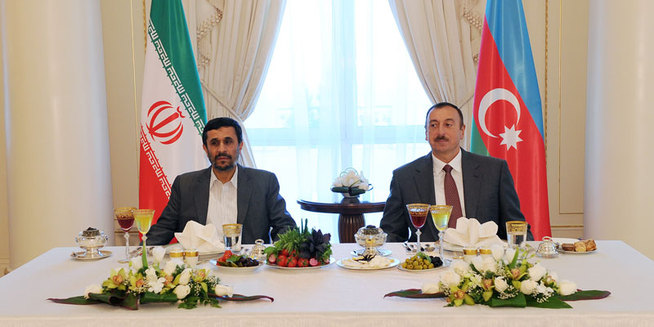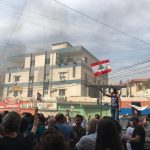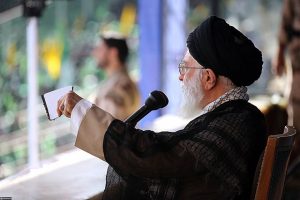by Gareth Porter
[While the terrible events in Egypt have delayed my plans to reply to ProPublica’s response to my critique of Sebastian Rotella’s report on the alleged build-up of Iran’s terrorist infrastructure in the Americas, Gareth Porter has written the following essay on a 2009 article by Rotella for the Los Angeles Times about an alleged bomb plot to blow up the Israeli Embassy in Baku, Azerbaijan, in 2008. It offers a very good illustration of some of the problems raised in my original critique of Rotella’s most recent work, notably the virtually exclusive reliance on sources that are clearly hostile to Iran with an interest in depicting it in the most negative light possible. But you be the judge. — Jim Lobe]
It happened in Baku, transforming the capital of Azerbaijan into a battleground in a global shadow war.
Police intercepted a fleeing car and captured two suspected Hezbollah militants from Lebanon. The car contained explosives, binoculars, cameras, pistols with silencers and reconnaissance photos. Raiding alleged safe houses, police foiled what authorities say was a plot to blow up the Israeli Embassy in Azerbaijan, a former Soviet republic that borders Iran.
Thus begins the only detailed English-language press account of an alleged Iranian terror plot in Azerbaijan in 2008: a May 2009 article, written with a Paris dateline, by Sebastian Rotella for the Los Angeles Times.
But despite the sense of immediacy conveyed by his lede, Rotella’s sources for his account were not Azerbaijanis. Rather, the sources Rotella quoted on the details of the alleged plot, the investigation and apprehension of the suspects consisted of an unnamed “Israeli security official”, and Matthew Levitt, a senior fellow at the pro-Israel Washington Institute for Near East Policy (WINEP) and the author of a constant stream of articles, op-eds, and Congressional testimony reflecting the Israeli government’s interest in promoting the perception of a growing Iranian terrorist threat around the world.[1]
It was Levitt who described the alleged plot in Baku to Rotella as having been “in the advanced stages” when it was supposedly broken up by Azerbaijani security forces, an assertion echoed by the anonymous Israeli security official cited in the article:
“[Iran] had reached the stage where they had a network in place to do an operation,” said an Israeli security official, who requested anonymity for safety reasons. “We are seeing it all over the world. They are working very hard at it.”
So readers of the LA Times received a version of the plot that was filtered primarily, if not exclusively, through an Israeli lens.[2] Relying on Israeli officials and a close ally at a pro-Israel US think tank for a story on an alleged Iranian bomb plot against an Israeli Embassy is bound to produce a predictable story line where the accuracy can hardly be assumed at face value. Indeed, in this case, there were and remain many reasons for skepticism.
Yet, three years later, in a July 2012 article for ProPublica, he referred to the plot as though it was established fact.
Had Rotella sought an independent source in Azerbaijan, he would have learned, for example, that such alleged plots had been a virtual perennial in Baku for years. That is what a leading scholar of Azerbaijan’s external relations, Anar Valiyev, told me in an interview last November. “It’s always the same plot year after year,” said Valiyev, Dean of the School of International Affairs of the Azerbaijan Diplomatic Academy in Baku.
In fact, security officials in Azerbaijan had claimed the existence of a similar plot in October 2007 and January 2012 and only two months later, authorities arrested Azerbaijani suspects in two different allegedly Iranian-initiated plots to carry out terrorist actions against Western embassies, the Israeli Embassy and/or Jewish targets. In early 2013, prison sentences were announced in yet another alleged terrorist plot to attack the Eurovision song contest in Baku in 2012. Valiyev told me that those detained by Azerbaijani security officials are always charged with wanting to kill Israeli or US officials and subsequently tried for plots to overthrow the government, which carries the maximum sentence of 15 years in prison.
In a 2007 article in Jamestown Foundation’s Terrorism Focus, Valiyev observed that plots, assassination and coup-attempts were “thwarted” with regularity in Azerbaijan. “Periodically the government finds a scapegoat,” he wrote, to justify attacks on domestic critics, including “Wahabbis”, followers of Kurdish-Sunni scholar Said Nursi and/or Shiite radicals. Valiyev suggested that security officials might be “trying to show that radical Islamists could come to power…should the incumbent government lose the election.”
The Azerbaijani government and its security forces are not known for their devotion to the rule of law. The current president, Ilham Aliyev, is the son of Azerbaijan’s first president, Heydar Aliyev, who, in turn, was the head of the Soviet KGB before Azerbaijan’s independence. According to Jim, who visited Baku last year, dissidents regard the first Aliyev’s tenure as relatively liberal compared that of his son. A 2009 State Department cable described Ilham Aliyev as a “mafia-like” figure, likening him to a combination of Michael and Sonny Corleone in the “The Godfather”.
Valiyev observed that virtually nothing about the alleged plot made sense, beginning with the targets. According to Rotella’s story, the alleged Hezbollah operatives and their Azerbaijani confederates had planned to set off three or four car bombs at the Israeli Embassy simultaneously, using explosives they “intended to accumulate” in addition to the “hundreds of pounds of explosives” they had allegedly already acquired from “Iranian spies.”
But the Israeli Embassy is located in the seven-story Hyatt Tower office complex along with other foreign embassies, and no automobiles are allowed to park in close proximity to the complex, according to Valiyev. So the alleged plotters would have needed a prodigious amount of explosives to accomplish such a plan.
For example, the bomb that destroyed the eight-story US Air Force barracks at the Khobar Towers in Saudi Arabia in 1996 was estimated at 23,000 pounds of explosives detonated less than 100 feet away from the building. Valiyev told me that it is “practically impossible to find such components in Azerbaijan” because “Even a few kilograms of explosives would be tracked down by the ministry of national security.”
In his article, Rotella also referred — though only in passing — to the prosecutor’s charge that the alleged conspirators were planning to attack a Russian radar installation at Gabala (sometimes spelled Qabala) in northern Azerbaijan. But that part of the plot was also highly suspect, according to Valiyev. No reason was ever given for such a target, and it would have made no sense for either Hezbollah’s or Iran’s interests.
Built in 1984, the Gabala radar station was leased to the Russians until 2012, and 900 troops from the Russian Space Forces were stationed there. An attack on the station by Hezbollah or its supposed proxies in Azerbaijan would have represented a major provocation against Russia by Iran and Hezbollah, and was therefore hard to believe, as Valiyev pointed out in a July 2009 report for the Jamestown Foundation. Valiyev said it was far more plausible that the alleged plotters were simply carrying out surveillance on the station which, according to some reports, was being considered for possible integration into a regional US missile defense system.
Rotella failed to mention yet another aspect of the prosecution’s case that should arouse additional skepticism. The indictment included the charge that the leader of the alleged terrorist cell plotting these attacks was working simultaneously for Hezbollah and al-Qaeda. Even though it has been long been discredited, the idea of an Iran-al-Qaeda collaboration on terrorism has been a favorite Israeli theme for some time and one that continues to be propagated by Levitt.
Rotella’s account of how the suspects were apprehended also appears implausible. In May 2008, when the bombings were supposedly still weeks away, according to his story, the suspects realized they were under surveillance and tried to flee.
But instead of hiding or destroying incriminating evidence of their terrorist plot — such as the reconnaissance photos, the explosives, the cameras and the pistols with silencers — as might be expected under those circumstances, the two suspects allegedly packed all that equipment in their car and fled toward the border with Iran, whereupon they were intercepted, according to the official line reported by Rotella.
Somehow, despite the surveillance, according to anonymous “anti-terrorist officials” cited by Rotella, “a number of Lebanese, Iranian and Azerbaijani suspects escaped by car into Iran.” Only those with the incriminating evidence — including, most implausibly, hundreds of pounds of explosives — in their car were caught, according to the account given to Rotella.
Even Rotella’s description of the two Lebanese suspects, Ali Karaki and Ali Najem Aladine, as a veteran Hezbollah external operations officer and an explosives expert, respectively, should not be taken at face value, according to Valiyev. It is more likely, he said, that the two were simply spies working for Iranian intelligence.
Even the US Embassy report on the trial of the suspects suggested it also had doubts about the alleged plot. “In early October after a closed trial,” the reporting cable said, “an Azerbaijani court sentenced a group of alleged terrorists arrested the previous Spring and supposedly connected to Lebanese Hezbollah plot to bomb the Israeli Embassy in Baku AND the Qabala radar station in northern Azerbaijan” (emphasis in the original). It added, “In a public statement the state prosecutor repeated earlier claims that the entire plot was an operation of the Iranian Revolutionary Guard.”
Yet another striking anomaly about the alleged plot was the fact that nothing was published about it for an entire year. No explanation for the silence was ever made public. This silence is all the more significant because during 2009 and 2010, the Israeli government either publicly alleged or leaked stories of Iranian or Hezbollah plots in Turkey and Jordan about which the host country authorities either did not comment on or offered a different explanation. But despite the extremely close relationship between Azebaijani and Israeli intelligence services (confirmed by this US Embassy cable), neither the Israeli media nor foreign journalists were tipped off to the plot until the Israelis leaked the story to Rotella a year later.[3]
The complete absence of any leak by the Israelis for an entire year about an alleged Iranian plot to bomb the Israeli Embassy in Baku casts some circumstantial doubt on whether such a plot had indeed been uncovered in 2008, as claimed in the article.
Despite the multiple anomalies surrounding this story — the complete lack of any publicly available corroborating evidence; the well-established penchant for the Aliyev government for using such alleged plots to justify rounding up domestic critics; the US Embassy’s apparent skepticism, his failure to consult independent sources; and the 2009 publication by the Jamestown Foundation of Valiyev’s own critique of the “official” version of the case — Rotella has shown no interest in clarifying what actually happened. In fact, as noted above, he referred to the plot again in a July 2012 article for ProPublica as if there was not the slightest doubt with regard to its actual occurrence, identifying it, as he did in the original article, as an attempted retaliation for the assassination of a senior Hezbollah operative three months before:
Conflict with Israel intensified in February 2008 after a car bomb in the heart of Damascus killed Imad Mughniyah, a notorious Hezbollah military leader and ally of Iranian intelligence. Iranian Hezbollah publicly accused Israel and vowed revenge.
Within weeks, a plot was under way against the Israeli Embassy in Azerbaijan. Police broke up the cell in May 2008. The suspects included Azeri accomplices, a senior Hezbollah field operative and a Hezbollah explosives expert. Police also arrested two Iranian spies, but they were released within weeks because of pressure from Tehran, Western anti-terror officials say.[4] The other suspects were convicted.
As narrowly sourced as it was, Rotella’s original 2009 story thus helped make a dubious tale of a bomb plot in Baku part of the media narrative. More recently, he continued that pattern by promoting the unsubstantiated charge by Argentine prosecutor Alberto Nisman and various pro-Israel groups and right-wing members of Congress, such as Florida Rep. Ileana Ros-Lehtinen, that Iran poses a growing terrorist threat to the US in the Americas. While Jim has helped deconstruct that story line, I have recently marshaled evidence showing that Nisman’s charges about alleged Iranian involvement in the 1994 AMIA bombing and the 2007 JFK airport plot were tendentious and highly questionable.
Photo: Iran’s former President Mahmoud Ahmadinejad at a dinner hosted by Azerbaijani President Ilham Aliyev in November 2010.
[1] In one illustration of Rotella’s and Levitt’s long-time symbiosis, Levitt cited Rotella’s account of the alleged Baku plot as his main source about the incident in a 2013 article on alleged Hezbollah terrorism published by West Point’s Combating Terrorism Center (CTC).
[2] Rotella referred twice to “anti-terrorism officials” as sources for describing the surveillance of the alleged perpetrators that preceded their arrest and past work for Hezbollah. Of course, the phrase “anti-terrorism officials” does not exclude the possibility that they, too, were Israeli.)
[3] The first time the alleged plot’s details appeared in the Anglophone Israeli press was when Haaretz published a several hundred-word piece based virtually exclusively on Rotella’s account with the added detail, citing “Israeli sources,” that the “plotters also planned to kidnap the Israeli ambassador in Baku…”
[4] This account, incidentally, was the first to report the arrest in the case of “two Iranian spies”, another anomaly that may be explained by a flurry of media reports in 2010 that it was the two Lebanese who were released as part of a larger prisoner exchange that also included an Azerbaijani nuclear scientist arrested as a spy by Iran.





Correct me if I’m wrong here, but isn’t this so-called investigative reporting of Mr Rotella, quite similar to what is coming out of Washington today by both the Administration and the various agency heads, “get it into print in the newspapers/on the internet, correcting after the fact? Perhaps what one would call: feeding the base? Of course, when called upon the story’s factual points, the correction is usually admitted some time down the road/at a latter date. Today, we seem to be inundated with the “anonymous source”, so-called because of the sources protection of its job. Later, we find out that much was just a figment of the authors imagination to sell his/her story or plain simple disinformation, usually from the Government, regardless of which Government being cited as a source. I just wonder, if Israel wasn’t in the middle of stirring the pot in the M.E., would the mess-I don’t know what else to call it except a “clusterfuck”-be taking place there?
Do you really believe that they haven’t tried stuff like this before? Is it so surprising that Iranian terror cells operate in countries like this? Is it an unwillingness to believe these guys are terrorists or a desire to stick your head in the sand and hope nothing happens?
gareth, keep up the good work
Though your latest “essay” focuses on a story by Sebastian Rotella while he was at the Los Angeles
Times, editors at ProPublica feel compelled to respond.
Careful readers will see that you misrepresent the breadth of sourcing in Sebastian’s reporting on the Baku case. On point after point, you rely on nothing more than supposition and generalizations about what is “plausible” or not. You repeatedly quote a sole source, Mr. Valiyev, whose views conveniently conform with your agenda. Yet, even then, you undercut your own argument by citing his opinion that the Hezbollah operatives convicted in the plot may have been “simply spies working for Iranian intelligence.”
Although you seem to believe that terrorist activity in Azerbaijan is purely a concoction of the authorities, U.S. embassy officials reacted very seriously to another alleged Iranian plot targeting them last year, as detailed in a Washington Post report.
Regarding bias in coverage of Iran, we note that Mr. Porter last year strongly suggested that a car-bomb attack injuring the wife of an Israeli diplomat and others wasperpetrated by Israel to cast suspicion on Iran. In other words, Israel would bomb its own diplomats for political gain.
Seriously?
We stand behind Mr. Rotella’s work.
/s/ The editors
ProPublica
I guess you don’t believe in collateral damage in your last paragraph? I might be naive in my cruising about the edges, but your sticking your foot into that old fashioned bucket as I see it.